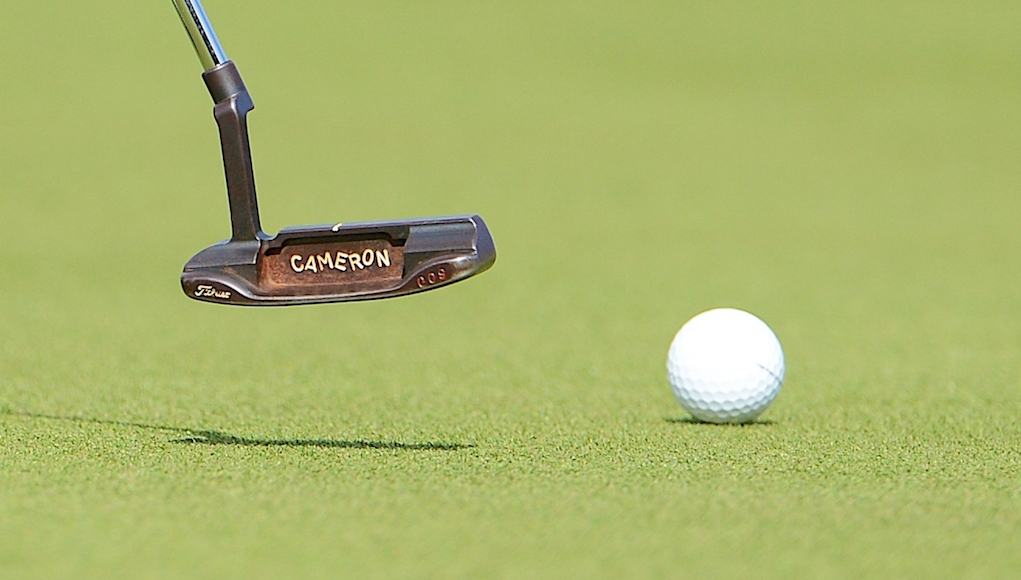Instruction
Four New Year’s Resolutions for golfers in 2014

Some people don’t believe in New Year’s resolutions, but golfers are hopeful types and we love setting new goals every winter. So, in that spirit I bring you some suggested golf resolutions for 2014. You may not adopt them all, but I promise that if you implement just one, you’ll lower your scores and have more fun. And isn’t that what golf is all about?
No. 1: Find yourself a coach
Bob Toski, a Hall of Fame instructor and five-time PGA Tour winner, once said that if he had anything to change about his teaching career, he would have been less enamored with the swing and would have taught more people how to play golf on the course. One of golf’s paradoxes is that we love so much to see the ball fly high, far and straight that we lose sight of the fact that improving our decision making and short game is the fastest way to shoot lower scores.
There is a coaching movement under way in golf and led by people like sports psychologist Dr. Rick Jensen and the great Canadian coach Henry Brunton. Coaches support their players and help them learn how to play good golf through a multifaceted long-term approach that includes playing lessons, not just by teaching them how to make good swings. I’m not saying that you shouldn’t work on your swing a little, but once you get to the point that you are no longer taking regular penalties because of errant tee shots, you should turn your focus mostly to short-game technique and learning on-course strategy.
No. 2: Spend some time learning to putt
I know this sounds a little harsh, but most golfers just don’t putt well and spend almost no time on it. Yet, putting is probably the area you can improve your scores with the least effort. The diagram above shows one of the reasons why most golfers struggle. We have all heard that the average player reads too little break into his putts (here, the purple line and circle). Better players, who think they should aim at the apex of the putt, are still aiming too low because gravity has already had its affect on the ball by the time it reaches its apex. Believe it or not, there are times when you need to aim a foot or more outside of what you previously thought was the top of the break. Consider the benefit of not regularly having a five- or six-footer coming back after your approach putt misses low and runs past the hole. Great putters play way more break than you would imagine and it takes practice to get yourself to do this consistently on the golf course.
A properly fitted putter, a good set up and an idea of how to aim properly are necessary, but there are far fewer physical requirements for good putting than for good ball striking. Most golfers, even very good players, just don’t know how to practice their putting. One thing you can do is stop dropping three balls on the putting green and hitting random putts. Instead, practice with a single ball and hit putts of varying lengths and breaks while going through the routine you’d use on the course. Place a tee or quarter just on the low side of what you think your line is and try to avoid hitting it. A simple drill like this will allow you to practice improvisation, which is what hitting shots on the course is really all about. A qualified putting instructor, like the men and women of the SeeMore Putting Institute, can fit you for a putter, give you an idea of what your aiming tendencies are and help you with technical instruction and practice strategies.
No. 3 Get smarter, and get yourself a short game
If I were to take the average players’ tee ball and walk it out to the middle of the fairway 150 yards from the green and let them play in from there, their scores wouldn’t improve that much. Try it some time. With all of the advances in technology, the average golfer still has a hard time breaking 100. Some of that is because golf courses have gotten longer and harder, but a lot of it is because the average golfer takes about 45 swings with the putter and hits 15 or more pitches and chips a round. I’m sure you’re sensing a theme here, but the answer is not to search out the perfect swing to hit more greens and hit the ball closer to the hole. The number of strokes most golfers can pick up from working diligently on their golf swing simply doesn’t compare to the potential dividends from work in the short game department. I have focused more and more in this area with my students and although they resist at first, they usually tell me later that it was one of the best things they have done for their golf.
Removing the flag from every green would also help most golfers’ scores. Why? As the above photo shows, you have a much larger margin of error if the ball flies off-line when you aim at the middle of a green. Clever tournament players understand they are not going to hit it perfectly every time and play most of their approach shots to the front and/or middle of every green depending on how they are designed. The typical amateur goes pin hunting every weekend. When he doesn’t loose his golf ball shooting at a tucked pin, he often ends up with an impossible second shot because he under-clubbed and aimed at the corner of a green.
No. 4: Golf is not the search for perfection
The truth is that most of our shots go at least a little off line, but thinking there is a perfect ball striking round out there is a vain pursuit. Skilled players who enjoy the game for a lifetime understand that, and are at peace with the fact that they may hit three or four shots a round just the way they planned. They also know that their sound short games can get them out of the tricky situations occasionally created by a miss. Peace of mind comes from a well-rounded skill set.
If you’re the type who chooses to think that golf is perfectible, you will always be disappointed and will never get the satisfaction of reaching your potential. Stop wasting energy. Focus on your target, embrace that the game is about overcoming adversity and doing your best to take advantage of opportunities. Do that, and you’ll love golf more than ever.
Oh, and Happy New Year!
Instruction
The Wedge Guy: Beating the yips into submission

There may be no more painful affliction in golf than the “yips” – those uncontrollable and maddening little nervous twitches that prevent you from making a decent stroke on short putts. If you’ve never had them, consider yourself very fortunate (or possibly just very young). But I can assure you that when your most treacherous and feared golf shot is not the 195 yard approach over water with a quartering headwind…not the extra tight fairway with water left and sand right…not the soft bunker shot to a downhill pin with water on the other side…No, when your most feared shot is the remaining 2- 4-foot putt after hitting a great approach, recovery or lag putt, it makes the game almost painful.
And I’ve been fighting the yips (again) for a while now. It’s a recurring nightmare that has haunted me most of my adult life. I even had the yips when I was in my 20s, but I’ve beat them into submission off and on most of my adult life. But just recently, that nasty virus came to life once again. My lag putting has been very good, but when I get over one of those “you should make this” length putts, the entire nervous system seems to go haywire. I make great practice strokes, and then the most pitiful short-stroke or jab at the ball you can imagine. Sheesh.
But I’m a traditionalist, and do not look toward the long putter, belly putter, cross-hand, claw or other variation as the solution. My approach is to beat those damn yips into submission some other way. Here’s what I’m doing that is working pretty well, and I offer it to all of you who might have a similar affliction on the greens.
When you are over a short putt, forget the practice strokes…you want your natural eye-hand coordination to be unhindered by mechanics. Address your putt and take a good look at the hole, and back to the putter to ensure good alignment. Lighten your right hand grip on the putter and make sure that only the fingertips are in contact with the grip, to prevent you from getting to tight.
Then, take a long, long look at the hole to fill your entire mind and senses with the target. When you bring your head/eyes back to the ball, try to make a smooth, immediate move right into your backstroke — not even a second pause — and then let your hands and putter track right back together right back to where you were looking — the HOLE! Seeing the putter make contact with the ball, preferably even the forward edge of the ball – the side near the hole.
For me, this is working, but I am asking all of you to chime in with your own “home remedies” for the most aggravating and senseless of all golf maladies. It never hurts to have more to fall back on!
Instruction
Looking for a good golf instructor? Use this checklist

Over the last couple of decades, golf has become much more science-based. We measure swing speed, smash factor, angle of attack, strokes gained, and many other metrics that can really help golfers improve. But I often wonder if the advancement of golf’s “hard” sciences comes at the expense of the “soft” sciences.
Take, for example, golf instruction. Good golf instruction requires understanding swing mechanics and ball flight. But let’s take that as a given for PGA instructors. The other factors that make an instructor effective can be evaluated by social science, rather than launch monitors.
If you are a recreational golfer looking for a golf instructor, here are my top three points to consider.
1. Cultural mindset
What is “cultural mindset? To social scientists, it means whether a culture of genius or a culture of learning exists. In a golf instruction context, that may mean whether the teacher communicates a message that golf ability is something innate (you either have it or you don’t), or whether golf ability is something that can be learned. You want the latter!
It may sound obvious to suggest that you find a golf instructor who thinks you can improve, but my research suggests that it isn’t a given. In a large sample study of golf instructors, I found that when it came to recreational golfers, there was a wide range of belief systems. Some instructors strongly believed recreational golfers could improve through lessons. while others strongly believed they could not. And those beliefs manifested in the instructor’s feedback given to a student and the culture created for players.
2. Coping and self-modeling can beat role-modeling
Swing analysis technology is often preloaded with swings of PGA and LPGA Tour players. The swings of elite players are intended to be used for comparative purposes with golfers taking lessons. What social science tells us is that for novice and non-expert golfers, comparing swings to tour professionals can have the opposite effect of that intended. If you fit into the novice or non-expert category of golfer, you will learn more and be more motivated to change if you see yourself making a ‘better’ swing (self-modeling) or seeing your swing compared to a similar other (a coping model). Stay away from instructors who want to compare your swing with that of a tour player.
3. Learning theory basics
It is not a sexy selling point, but learning is a process, and that process is incremental – particularly for recreational adult players. Social science helps us understand this element of golf instruction. A good instructor will take learning slowly. He or she will give you just about enough information that challenges you, but is still manageable. The artful instructor will take time to decide what that one or two learning points are before jumping in to make full-scale swing changes. If the instructor moves too fast, you will probably leave the lesson with an arm’s length of swing thoughts and not really know which to focus on.
As an instructor, I develop a priority list of changes I want to make in a player’s technique. We then patiently and gradually work through that list. Beware of instructors who give you more than you can chew.
So if you are in the market for golf instruction, I encourage you to look beyond the X’s and O’s to find the right match!
Instruction
What Lottie Woad’s stunning debut win teaches every golfer

Most pros take months, even years, to win their first tournament. Lottie Woad needed exactly four days.
The 21-year-old from Surrey shot 21-under 267 at Dundonald Links to win the ISPS Handa Women’s Scottish Open by three shots — in her very first event as a professional. She’s only the third player in LPGA history to accomplish this feat, joining Rose Zhang (2023) and Beverly Hanson (1951).
But here’s what caught my attention as a coach: Woad didn’t win through miraculous putting or bombing 300-yard drives. She won through relentless precision and unshakeable composure. After watching her performance unfold, I’m convinced every golfer — from weekend warriors to scratch players — can steal pages from her playbook.
Precision Beats Power (And It’s Not Even Close)
Forget the driving contests. Woad proved that finding greens matters more than finding distance.
What Woad did:
• Hit it straight, hit it solid, give yourself chances
• Aimed for the fat parts of greens instead of chasing pins
• Let her putting do the talking after hitting safe targets
• As she said, “Everyone was chasing me today, and managed to maintain the lead and played really nicely down the stretch and hit a lot of good shots”
Why most golfers mess this up:
• They see a pin tucked behind a bunker and grab one more club to “go right at it”
• Distance becomes more important than accuracy
• They try to be heroic instead of smart
ACTION ITEM: For your next 10 rounds, aim for the center of every green regardless of pin position. Track your greens in regulation and watch your scores drop before your swing changes.
The Putter That Stayed Cool Under Fire
Woad started the final round two shots clear and immediately applied pressure with birdies at the 2nd and 3rd holes. When South Korea’s Hyo Joo Kim mounted a charge and reached 20-under with a birdie at the 14th, Woad didn’t panic.
How she responded to pressure:
• Fired back with consecutive birdies at the 13th and 14th
• Watched Kim stumble with back-to-back bogeys
• Capped it with her fifth birdie of the day at the par-5 18th
• Stayed patient when others pressed, pressed when others cracked
What amateurs do wrong:
• Get conservative when they should be aggressive
• Try to force magic when steady play would win
• Panic when someone else makes a move
ACTION ITEM: Practice your 3-6 foot putts for 15 minutes after every range session. Woad’s putting wasn’t spectacular—it was reliable. Make the putts you should make.
Course Management 101: Play Your Game, Not the Course’s Game
Woad admitted she couldn’t see many scoreboards during the final round, but it didn’t matter. She stuck to her game plan regardless of what others were doing.
Her mental approach:
• Focused on her process, not the competition
• Drew on past pressure situations (Augusta National Women’s Amateur win)
• As she said, “That was the biggest tournament I played in at the time and was kind of my big win. So definitely felt the pressure of it more there, and I felt like all those experiences helped me with this”
Her physical execution:
• 270-yard drives (nothing flashy)
• Methodical iron play
• Steady putting
• Everything effective, nothing spectacular
ACTION ITEM: Create a yardage book for your home course. Know your distances to every pin, every hazard, every landing area. Stick to your plan no matter what your playing partners are doing.
Mental Toughness Isn’t Born, It’s Built
The most impressive part of Woad’s win? She genuinely didn’t expect it: “I definitely wasn’t expecting to win my first event as a pro, but I knew I was playing well, and I was hoping to contend.”
Her winning mindset:
• Didn’t put winning pressure on herself
• Focused on playing well and contending
• Made winning a byproduct of a good process
• Built confidence through recent experiences:
- Won the Women’s Irish Open as an amateur
- Missed a playoff by one shot at the Evian Championship
- Each experience prepared her for the next
What this means for you:
• Stop trying to shoot career rounds every time you tee up
• Focus on executing your pre-shot routine
• Commit to every shot
• Stay present in the moment
ACTION ITEM: Before each round, set process goals instead of score goals. Example: “I will take three practice swings before every shot” or “I will pick a specific target for every shot.” Let your score be the result, not the focus.
The Real Lesson
Woad collected $300,000 for her first professional victory, but the real prize was proving that fundamentals still work at golf’s highest level. She didn’t reinvent the game — she simply executed the basics better than everyone else that week.
The fundamentals that won:
• Hit more fairways
• Find more greens
• Make the putts you should make
• Stay patient under pressure
That’s something every golfer can do, regardless of handicap. Lottie Woad just showed us it’s still the winning formula.
FINAL ACTION ITEM: Pick one of the four action items above and commit to it for the next month. Master one fundamental before moving to the next. That’s how champions are built.
PGA Professional Brendon Elliott is an award-winning coach and golf writer. You can check out his writing work and learn more about him by visiting BEAGOLFER.golf and OneMoreRollGolf.com. Also, check out “The Starter” on RG.org each Monday.
Editor’s note: Brendon shares his nearly 30 years of experience in the game with GolfWRX readers through his ongoing tip series. He looks forward to providing valuable insights and advice to help golfers improve their game. Stay tuned for more Tips!
























Pingback: Around The Links: A new Year Begins In Hawaii - Pro Golf Now - A Pro Golf Blog
Brian
Jan 2, 2014 at 9:56 pm
Good read…I fully expected to read 1 thru 4 = play faster.
Paul Kaster
Jan 3, 2014 at 10:39 am
Yes, that’s a tough one Brian. We’ve been doing a lot of work on that at High Bridge Hills.
jtobrien
Jan 1, 2014 at 4:41 am
#4 is spot on.
Sean
Dec 31, 2013 at 7:33 pm
My instructor is a big advocate of #1. I already work on 2/3, and I need to work on 4. 🙂
Paul Kaster
Jan 1, 2014 at 1:49 pm
Most of us do need work on #4, Sean. Glad you enjoyed it
Ma
Dec 31, 2013 at 6:54 pm
Get Tiger to stop cheating.
jags
Jan 1, 2014 at 12:48 pm
It’s not cheating if you’re single
Eric
Jan 1, 2014 at 12:56 pm
Haters be hating….Keep pulling for Phil,and keep finishing second….At best! 🙂
Shawn
Jan 2, 2014 at 3:00 pm
I’m absolutely fascinated by the people who feel the need to run around on the internet and play morals police about people they’ve never met.
Please, tell me more.
markb
Dec 31, 2013 at 4:57 pm
Amen to no. 3! Just before my course switched to winter set-up (two holes permanently punched on every green) the GK forgot to put flags back in one day when I was first out. With no flags I had to go at center green every hole. I found I hit far more greens than normal and I wasn’t that far from either cup. I’m trying to stick with it, but coquettish flapping flags keep tempting me.
Paul Kaster
Jan 1, 2014 at 1:50 pm
This one takes discipline, but can account for a lot of “strokes gained” very quickly once you get it.
Bob Forman
Dec 31, 2013 at 3:22 pm
I’d like to add a 5th. Fix the mechanism that’s swinging the club. . . that’s your body. Guaranteed to help.